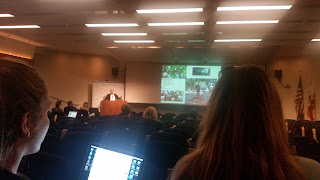Blogpost 6- Neuroscience and Art
| (Neuroaesthetics) |
There is the study of art and the brain called Neuroaesthetics. This is studying art while using neuroscience (Noe). This is the idea that art is made in the brain and that there may be science behind art. Researches look at events in brains to have an understanding of art (Noe). This is interesting as I sometimes wonder why some are more artistic than others and this can help explain why. This seems like an interesting field to go into for the final.
| (Recognizing Faces) |
| (Baby looking at his face in mirror) |
Another article I read was by CNN and it goes into what the brain recognizes in art, mainly lines, faces, and color. Line drawings are an outline that one can picture without the lines. For example, someone drawing a picture of your room, your brain can tell it is your room even though the objects in your room are not outlined in black (Landau). They are the same neural networks we see in the real word so it is easily recognizable (Landau). Next, faces are another easily recognizable thing in works of art. Even if it is is upside down and barely resembles a face, we can still recognize it. In psychology class, I learned that infants are able to recognize faces, especially ones that look like their mom. Interestingly, the amygdala is most responsive to blurry faces that show fear (Landau). Last, the brain can easily pick up on color. Something called luminance reads the color from the cons in the eye and puts it together. The cons can only see blue, red, and green, but luminance can figure out what the right color is. Also, all colors have the same level of brightness. Artists know this and play around with it to give their paintings a 3-D sense (Landau)
In conclusion, it seems that neuroscience and art do go together. Whether it is neuroaesthetics and understanding art while using neuroscience, or how the brain recognizes art.
Sources
Landau, Elizabeth. "What the Brain Draws From: Art and Neuroscience." CNN. Cable News
Network, 15 Sept. 2012. Web. 21 May 2017.
Momastic. Do Infants Recognize Themselves in Mirrors. Photograph.
Noë, Alva. "Art and the Limits of Neuroscience." The New York Times. The New York Times, 04
Dec. 2011. Web. 21 May 2017.
Viral Nova. Check Out What Faces Are Hidden. Photograph.


Comments
Post a Comment